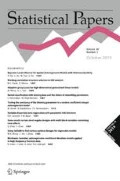Zusammenfassung
Unter der Voraussetzung der Translationsinvarianz der zur Ausgleichung nach der Methode der kleinsten Quadrate benutzten Funktionen lassen sich die Schätzungen bzw. Prognosen mit Hilfe relativ einfacher Rekursionsbeziehungen für neuere Beobachtungsdaten fortschreiben. Das wird vonJosef Kozák (Prag) in der vorliegenden Arbeit ausführlich dargestellt und dann auf drei wichtige Fälle angewendet:
-
(i)
Exponentielle Ausgleichung (die Streuungen der Störglieder bilden eine exponentiell abnehmende Folge): hier werden vonJ. Kozák Arbeiten vonMeyer, Brown undDobbie verallgemeinert.
-
(ii)
Homoskedastizität (alle Störstreuungen sind gleich).
-
(iii)
Saisonale Heteroskedastizität (die Störstreuungen bilden eine periodische Folge).
Summary
Under the assumption of translational invariance of the functions which are used for least squares smoothing, those estimations and predictions may be up-dated by means of relatively simple recursive formulae. This procedure is described in detail byJosef Kozák (Prague) in the present paper, and is then applied to three cases:
-
(i)
Exponential smoothing (the variances of the shock variables form an exponentially decreasing sequence): hereJ. Kozák generalizes results ofMeyer, Brown, andDobbie.
-
(ii)
Homoscedasticity (the shock variances are constant).
-
(iii)
Seasonal heteroscedasticity (the shock variances form a periodic sequence).
Résumé
Sous l’hypothèse de l’invariance translationnelle pour les fonctions utilisées pour l’ajustement selon la méthode des moindres carrés, les estimations et prédictions qui en résultent peuvent être adaptées à nouvelles observations par des formules récursives relativement simples. Ce procédé est exposé parJosef Kozák (Prague) dans l’article que voici, et appliquée à trois situations:
-
(i)
Ajustement exponentielle (les variances des erreurs forment une suite exponentiellement décroissante): pour ce cas, l’auteur généralise les résultats deMeyer, Brown etDobbie.
-
(ii)
Homoscédasticité (les variances des erreurs restent constantes).
-
(iii)
Hétéroscédasticité saisonnière (les variances forment une suite périodique).
Резуме
При условии транслационной инвариантности использованных для выравнивания способом наименьщих квадратов функций оценки или прогнозы могут применяться и к более актуальным Эмпирическим данным при помоши сравнительно простых рекуррентных отнощений. В данной работе Это подробно излагается Йосефым Кожаком (Прага) и после Этого применяется к трем важным случаям:
-
I.
Экспоненциальное выравнивание (рассеяние остаток образует убываюший ряд): Й Кожак здесь обобшает труды Мейера, Брауна и Добби.
-
II.
Гомоскедастичност ь (все остатки одинаково рассеяны).
-
III.
Сезонная гетероскедастичнос ть (рассеяние остаток образует периодический ряд).
Literaturverzeichnis
Brown, R. G., Smoothing, Forecasting and Prediction of Discrete Time-Series. Englewood Cliffs, N. J. (Prentice Hall) 1963.
Dobbie, J. M., Forecasting Periodic Trends by Exponential Smoothing. Operations Research, 11 (1963), S. 908–918.
Goldberger, A. S., Econometric Theory. New York-London-Sydney (Wiley) 1964.
Meyer, R. F., An Adaptive Method for Routine Short-Term Forecasting. Proceedings of the 3rd International Conference on Operations Research, Oslo 1963.
Kozák, J., Metodika analýzy sezonně zatižených časových řad ekonomických ukazatelú. Praha 1966 (Manuskript).
Rights and permissions
About this article
Cite this article
Kozák, J. Drei Möglichkeiten der vereinfachten Prognoserechnung unter der Voraussetzung der Translationsinvarianz. Statistische Hefte 8, 252–262 (1967). https://doi.org/10.1007/BF02922579
Issue Date:
DOI: https://doi.org/10.1007/BF02922579

